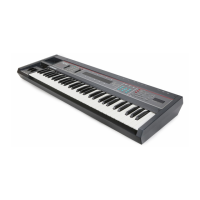SO-80 — Musician's Manual
Digital Sequencing
A general understanding of how a Digital Sequence Recorder like the SQ-80 does what it does, and how
it differs from an eight-track audio tape recorder, will help you to get the most out of your instrument.
The key thing to bear in mind is this — the Sequencer only records what you play. Sequencer Memory
is used up on the basis of Events
(Keys struck, Controllers, etc.), while a tape recorder's memory (the
tape) is always used up by the same amount over a fixed period of time.
This means that a Sequencer will use virtually the same amount of Memory to record 100 notes, whether
you play those notes over ten seconds or ten minutes. When you strike a key, the Sequencer records a
Key Down.
It then counts the Clock pulses until you release the key, when it records a Key Up. The
amount of time between the Key Down and the Key Up doesn't really affect the amount of Memory
required to record the note.
Compare this to an audio tape recorder. With tape, Time
is the thing. A tape recorder will use the same
amount of tape to record a minute of music, whether the signal contains one note or one hundred.
You might say that tape is linear
— it is spent at a fixed rate — while Digital Sequencer Memory is
dynamic
— it is used only as needed. The difference is essential to learning how to manage the SQ-80's
Sequencer Memory. For example, while Key Events (the notes you play) use up relatively little Memory
each, Controllers
such as MOD Wheel. Pitch Bend, Breath controller. etc., are recorded as a flood o
numbers which can fill up the Memory in a hurry. Thus if you're trying to squeeze one more Track into
a Sequence when there is not much Memory left, you know to go easy on the Controllers.
82 Section 4 — The Sequencer

